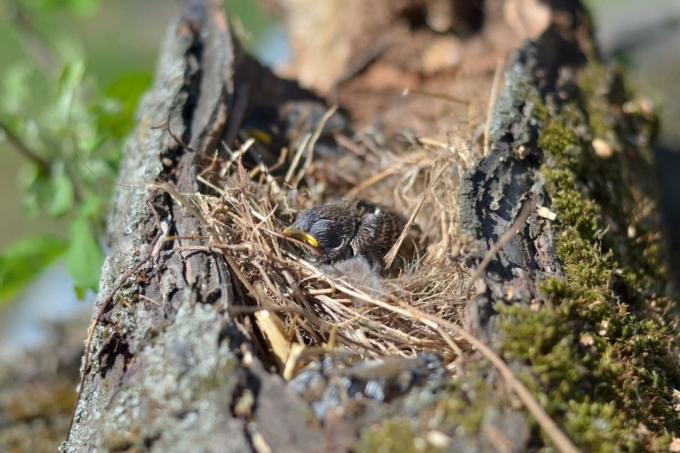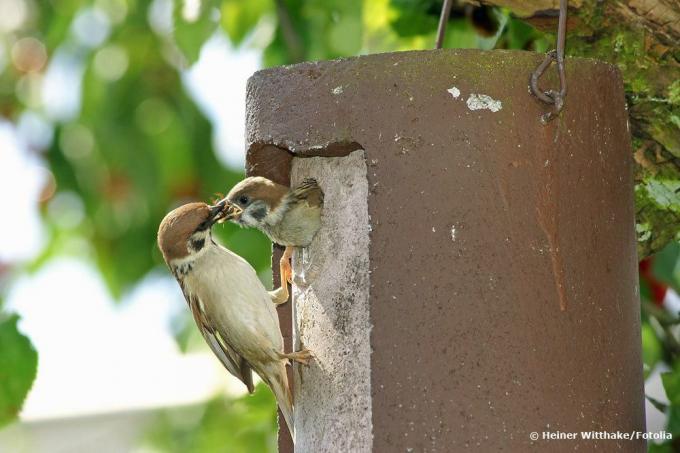
table of contents
- Main breeding season for sparrows
- Duration of a breeding season
- Nesting place
- frequently asked Questions
For a long time the sparrow was considered threatened, but now it is slowly reclaiming the local cities and gardens. You can find out more about the sparrows' breeding season, timing and nest building in the following article.
In a nutshell
- Sparrows hatch the eggs for about 14 days
- the direct breeding season depends on the ambient temperatures
- can take two days longer in spring when the temperatures are cooler
- Summer with hot temperatures one to two days shorter
- Sparrows breed up to three times between April and August
Main breeding season for sparrows
The sparrows' courtship and breeding season lasts a long time, as the sparrows breed between one and three times during this time. The first mating and courtship begins in April. The last one can definitely only take place in August. The late breeding is also due to the fact that the sparrows are resident birds and are the last brood does not have to fledge so quickly, as they do not have to go to southern climes, as is the case with many others
Bird species the case is.After the young birds no longer have to be fed by their parents and can take care of themselves, the next courtship and breeding season begins for the older sparrows. The young will not provide a new brood until next year.

Note: In the case of the sparrows, males and females alternate with brooding during the day, but at night usually only the female sits in the nest to keep the eggs warm.
Duration of a breeding season
- Breeding time approx. two weeks
- Depending on the outside temperature, two days shorter or longer
- longer in April
- often shorter in summer
- Young birds stay in the nest for about 16 days
- after leaving, they remain knotty stools
- continue to be fed by their parents
- but here also easy prey for predators
- after a further eight days the young sparrows become independent

The duration of a single breeding season for a sparrow (Passer domesticus) in which the laid Eggs hatched and the young birds grow until they leave the nest, also depends on various factors:
Nesting place
Originally, sparrows lived in large populations in tree savannahs. But after the humans settled down, the birds sought to be close. So the optimal habitat for a sparrow today is a village or the outskirts, where agriculture is operated, there are open keeping of animals or parks and gardens are happy to also offer gastronomy are located. Therefore, there are many nesting places for the birds in the inner cities, because there are enough food Is found. the Nests are created by sparrows during the breeding season as follows:
- Nest in a confined space
- many nests next to each other
- in small columns and Cavities on buildings
- Sparrows are sociable birds
- raise the young birds together
- better defense of the nests in the swarm against magpies, for example
- old nests are repaired and used again

Note: There weren't always sparrows in America. It was not until 1851/52 that New York citizens released 100 house sparrows in a Brooklyn cemetery. The birds took on their new home and are still widespread today.
frequently asked Questions
The sparrows have lived in a kind of community with humans for 10,000 years. Because when people settled down and started farming, the also very localized sparrows simply stayed there. Because the birds usually move only a few kilometers away from their place of birth. In close proximity to humans, the animals find sufficient food and suitable nesting places.
Each brood has around four to six eggs that are hatched. If you do the math, a pair of sparrows will hatch up to 18 eggs per year if three broods are assumed between April and August. If this is extrapolated again to a whole sparrow population, then that sounds like a lot at first. Yet less than 50% of the young birds survive each year.
The sparrows multiply quite quickly if the hatched eggs are assumed in the year. But since the adult animals do not reach old age either, this is also important for the maintenance of the population. Because of the young birds that survive immediately after hatching, only about 20% will survive the first year, after which a sparrow can reach an age between three and six years.
Yes, once the animals have decided on a partner, they will have a lifelong permanent relationship with him. However, the partners do not stay alone when the other dies but look for a new life partner at the next courtship.



